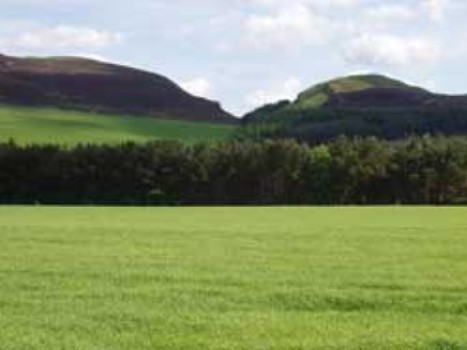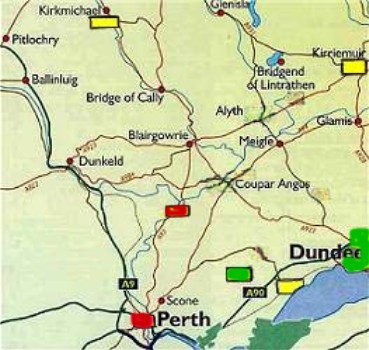

The village of Cargill is situated in Strathmore Valley (picture, above left) about 5 miles south-west of Coupar Angus and 9 miles north-east of Perth. It is near the confluence of the Tay and Ila Rivers and is shown by the red rectangle near the center of the map above right.
There are two possible Celtic origins of its name. One theory suggests that it came from two words: Caer signifying a village, and Gill meaning a place of worship or burial. The most authoritative origin suggests that the word means white fort - taken after the old Roman camp which is in the vicinity. The Romans had a number of camps in the region as well as a road linking them all.
I found little information on the web describing Cargill's early history; however, the Statistical Accounts give us a glimpse into the community in the 1790s. From that account, we learn that the parish was primarily agricultural with some weaving, wood harvesting, and fishing (salmon in the Tay and Ila Rivers). With the exception of some woodlands, the countryside was all arable. Crops included wheat, barley, oats, peas, turnips, grasses, potatoes, and flax. Enough produce was grown to not only feed the inhabitants, but to provide a considerable supply of wheat to the bakers and of barley to the distilleries and breweries in Perth and Coupar Angus.
At one point, the farmlands were infested with gool - a weed with a yellow flower that grew among the corn crops. Cargill's Barony Court promulgated an act under which tenants of the lands would be fined 3 shillings or a sheep for each stock of gool that was found growing among their crops on a designated day. On that day, persons known as gool riders were hired to ride through the farms levying such fines as were necessary. By the 1790s, the infestation had been controlled and the fine reduced to 1 pence; however, the practice of gool riding remained.
Near the turn of the century, there were a number of macro-events in Cargill (and throughout Scotland) which affected the village and, in particular, small farmers such as the Wightons.
Some time after 1745, the lands of the Baron of Stobhall and the Baron of Cargill who supported the Jacobite revolution were confiscated and given to the Commissioners of the Annexed Estates to administer. The Cargill lands were only a small piece of all of the lands confiscated under an Act of Parliament which allowed the government to acquire the estates of traitors and Popish recusants. These estates were primarily in the Highlands, but in Cargill, the land from the two barons that the government confiscated constituted about 3/4 of the land in the parish. As might be expected with a government body managing a widely dispersed set of estates, they were not particularly well run. The author of the Statistical Accounts noted that the Cargill parish lands under the government's control had been rented for years at a very low rate.
At some point prior to the 1790s, the annexed estates in Cargill were restored to the heirs of the former owners and rents were quickly and considerably raised. For example, one farm's annual rent went from 33 Pounds to 200 Pounds; another rose from 23 Pounds to 90 Pounds. This restoration of the estates must have been fairly recent since the author of the Statistical Accounts in 1790 noted that although there were a few large farms in the parish, most were small with rents of 20-30 Pounds annually. Although these small farmers held long leases, they were, in effect, discouraged from making improvements to their land or cottage since those improvements would allow the landowner to increase the rents. By the 1790s, it was clear that the plan of the heritors of the estates was to combine small farms into large ones as soon as the leases expired.
The second macro-event to influence small farmers in Cargill was the rapid rise of the costs of labour. The author of the Statistical Accounts noted that labour costs had doubled since he had moved into Cargill in 1785. This increase was likely due to increased demand for labour from other sources, for example the construction of turnpikes and the allure of mills and factories in the larger cities. Moreover, those outside jobs paid labourers in money, rather than in goods. Farmers found the increase in labour costs, and the expenses of farming equipment, more burdensome than the increase in their rents.
The construction of turnpikes did more than increase labour costs. In Cargill's case, the village was on a turnpike connecting Perth with Coupar Angus. The tolls from the turnpike allowed crossroads to be better maintained and new turnpikes to be built. All of this meant that it was becoming much easier for people and products to move around the countryside. With Perth only 9 miles away on a turnpike, Cargill's landowners had a clear incentive to maximize the value of their lands by consolidating small farms into large farms where new agricultural methods and equipment could increase their production and thus their profits.
Sources
Various web sites, including
Statistical Accounts of Scotland (http://stat-acc-scot.edina.ac.uk/)
Further reading: Wighton Families in Cargill